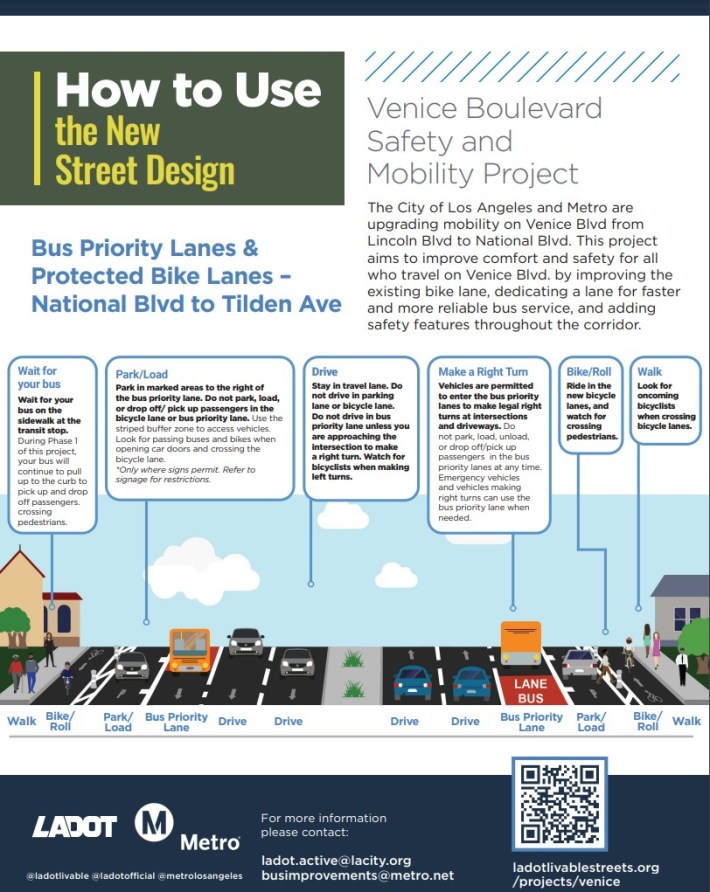
Yesterday, Los Angeles City and Metro celebrated the official opening of bus and bike upgrades on Venice Boulevard through West Los Angeles. The city Transportation Department's (LADOT) Venice Boulevard Safety and Mobility Project added 2.1 miles of new 24/7 bus-only lanes between Inglewood Boulevard and Culver Boulevard.
Specifically, the project includes 1.6 miles of two-way bus lanes from Culver Boulevard to Tilden Avenue and 0.5 miles of eastbound bus lane from Bledsoe Avenue to Inglewood Boulevard.

The bus-only lanes, approved nearly a decade ago in the city's Mobility Plan, required removal of a general travel lane in each direction, reducing Venice from six car lanes to four. This lane reconfiguration is called a road diet.
New bus and protected bike lanes on Venice Boulevard are now officially open!
— Metro Los Angeles (@metrolosangeles) June 26, 2023
Birds eye view of our Line 33 bus: pic.twitter.com/IzznH33hI7
The project also included pedestrian and bike features. For safer walking, LADOT upgraded crosswalks to the newer higher-visibility zebra standard version.
For cyclist safety, LADOT added parking protection to about 2.5 miles of existing bike lanes from McLaughlin Avenue to National Boulevard.
Unfortunately, in the late stages of the project (after the September 2022 community meeting), LADOT made significant cuts to the design, shedding about 0.7 mile (28 percent) of 2.5 miles of planned bus lanes, and about a mile (27 percent) of 3.6 miles of planned bike upgrades.
According to a project update flier from late 2022, the proposed bus lane sections were omitted to "maintain three general travel lanes where [car] traffic is heaviest between Sawtelle and Sepulveda [Boulevards]... [to] allow vehicles to merge freely as they approach or depart the I-405 freeway on/off ramps." The bikeway protection was dropped "to retain all curbside parking... where residential parking demand is high." As originally planned, the bikeway would have been L.A. County's longest stretch of protected lanes. As implemented, it has a third-of-a-mile-long gap midway. Some of the omitted bikeway upgrades (from Lincoln Boulevard to Beethoven Street) are listed as part of a future phase 2, but no date is specified.
Yesterday's opening ceremony focused on the positive aspects of the project, and there are plenty of on-the-ground improvements to celebrate.
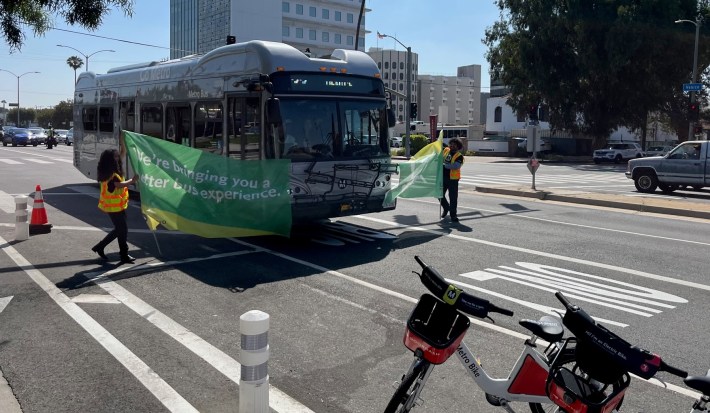
City and Metro leaders arrived onboard a special Metro electric bus, which broke through a tall banner.
L.A. Councilmember and Metro Boardmember Katy Young Yaroslavsky (who took office during the Venice project construction) enthusiastically celebrated the project as "a really big deal." Drawing attention to the corridor's history of car crashes resulting in fatalities and serious injuries, Yaroslavsky noted it would "save lives" and expressed her support for L.A. becoming "a great bike city."
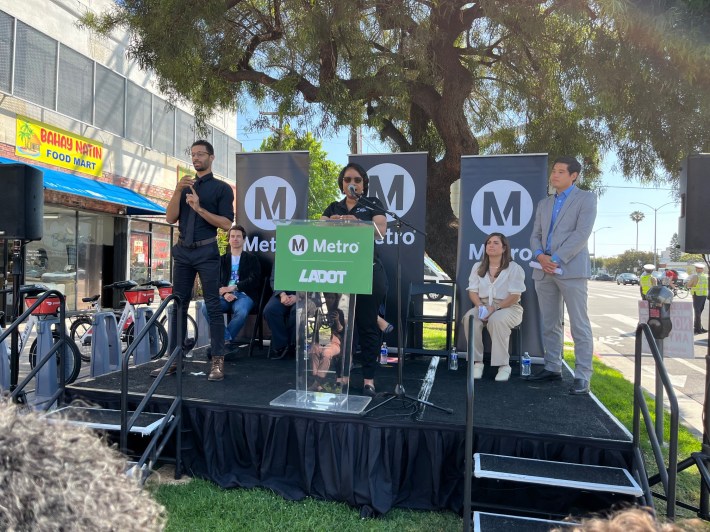
Metro CEO Stephanie Wiggins praised bus lane improvements as centering customers in everything Metro does. LADOT Interim General Manager Connie Llanos upheld the "momentous" project as an example of what LADOT and Metro can partner together to do throughout Los Angeles. Indeed, Metro and LADOT have already collaborated on seven new bus-only lane stretches in the past couple years, with additional bus lanes on the way: La Brea Avenue, Sepulveda Boulevard, Florence Avenue, and Roscoe Boulevard.
Katrina Kaiser of the Palms Neighborhood Council and Streets for All (SFA) pointed to the importance of community outreach in getting this project successfully installed. Both Kaiser and SFA founder Michael Schneider noted that the current improvements grew out of SFA's Venice Boulevard for All campaign, and that that campaign continues to press for extending the busway and bikeway improvements from downtown to the ocean.
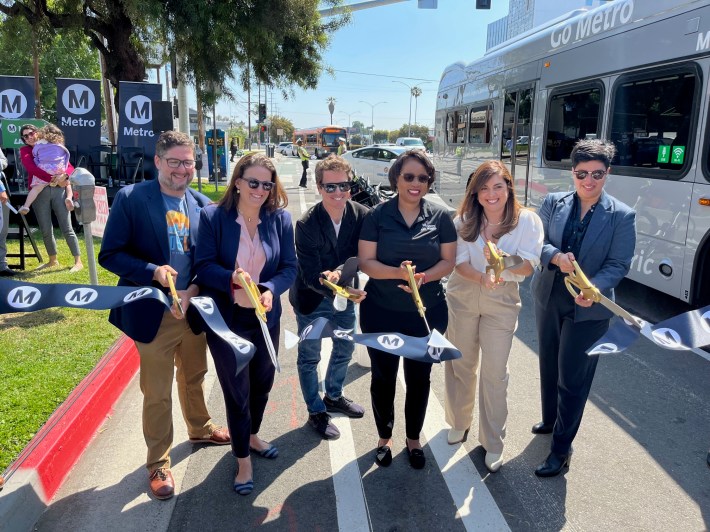
After speeches, Yaroslavsky, Wiggins, Llanos, Kaiser, and Schneider cut a ceremonial ribbon to open the bike lane, then they all hopped on Metro Bike Share bikes for an inaugural ride.
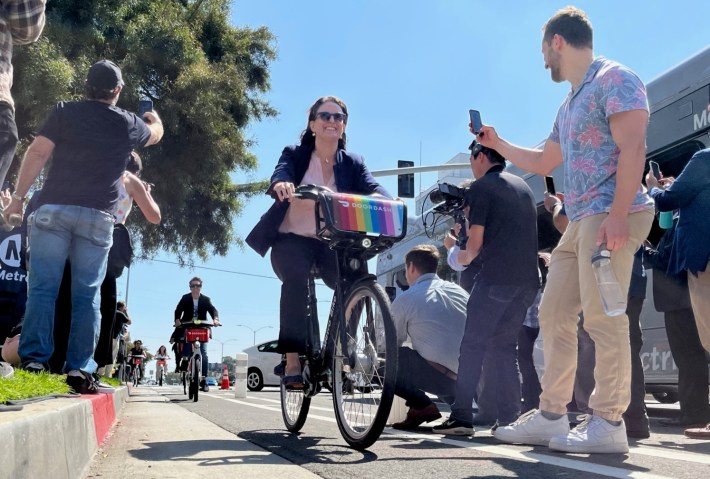
Since SBLA last reported on Venice's then-half-done protected lanes back in March, the city has added green striping in conflict zones.


